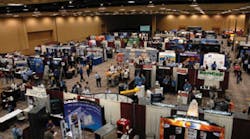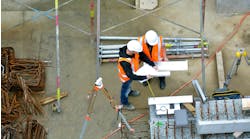The BICSI Fall 2006 meeting at the MGM Grand Conference Center in Las Vegas, held Sept. 18-21, drew more than 3,000 information transport system (ITS) professionals looking for network-integrating solutions that balance performance, scalability, and cost. From the educational sessions to the exhibit hall, interest in the emerging 10G market was quite evident. The application standard for 10 Gbps (1,250 Mbps) Ethernet over unshielded twisted pair copper cabling (called IEEE 8023an) was ratified in June 2006. Although this was certainly a hot topic, there were several other popular issues being bantered about by attendees. Following are some highlights straight from the show floor.
Tracking trends. The TIA TSB (Telecom Service Bulletin) 155 titled “Additional Guidelines for 4-pair 100 Ohm Category 6 Cabling for 10BASE-T Applications” was also approved by its developing committee and is now undergoing formal approval. This TSB helps a user transmit 10GBASE-T over installed Cat. 6 systems having a horizontal length of less than 100 meters.
A performance standard called “Transmission Performance Requirements for 4-Pair 100 Ohm Augmented Category 6 Cabling” still awaits approval and publication. This document is for new Cat. 6a (augmented) cabling to handle 10GBASE-T applications over the full 100 meters. The augmented Cat. 6 standards committee has identified alien near-end crosstalk (ANEXT) as the significant factor limiting 10GBE performance over a 100-meter copper channel. This ANEXT occurs when the cable under consideration absorbs signals from nearby cables and connecting hardware. To solve the problem, the standards will likely call for loose, random placement of Cat. 6a cabling in a pathway, such as a cable tray, rather than having tight, twisted bundles.
A 10GBASE-T system is ideal for backbone networks serving users, and if copper cabling is satisfactory at these speeds, it can reach virtually all the workstations in the horizontal distribution within a building. Initial demand will be for data centers, and perhaps as a lower cost alternative to optical fiber for storage area networks connecting disk drives to servers and LANs.
Data center design is also on the minds of many, as concerns grow about space usage, power consumption, and server costs. Many data centers can consume 50 W/sq ft, and forecasts indicate that the loading could grow to as high as 300 W/sq ft. Many new rack/cabinet designs and cable management hardware were evident on the exhibit floor. Another important consideration with high bandwidth networks is pathway design and sizing to handle the combination of high equipment density and the greater cable diameters needed to support 10 Gbps transmission. The new TIA/EIA-942 standard provides guidance on designing and building a data center, with primary focus placed on cabling systems and cabling pathways.
In addition to getting the latest word on the street, attendees also benefited from networking with their peers as well as having access to presentations through the multifaceted educational track.
Session recap. The opening presentation of the general session on Tuesday was titled “Optical Fiber to the Premise,” by William Belben, Verizon Communications, Boston. In this seminar, he described a multi-billion-dollar deployment of optical fiber to residential and commercial customers currently underway. Called Fiber to the Premise (FTTP), the network is passive right into the living unit. This design eliminates the costs involved in maintaining active opto/electronic equipment, such as an optical power splitter, within a pedestal for example.
In optical networks, the primary challenge is to organize the digital traffic so that a single fiber can simultaneously accommodate different types of signals. Voice and video, for example require nearly constant data rates, whereas file transfers and e-mail can be transmitted in intermittent streams. In this system, wavelength division multiplexing is used; that is, three separate dedicated wavelengths — 1310nm, 1490nm, and 1550nm — all carried on the same fiber, from the optical line terminal to the fiber distribution hub or distributional terminal. The various size equipment cabinets — serving multiple customers or single customers — are installed between studs, so there is no impact on rentable square footage. This delivery of digital voice, video, and data services over optical fiber may be the door opener for large-scale broadband usage in a household.
Although it is currently fragmented, the residential market is rapidly consolidating. Currently, the top 100 builders in the United States represent almost 40% of the market, with the top 10 builders on the list having a 20% share. However, 60% of the volume is still held by smaller and often local builders.
Consider, for example, a California community of 20,000 residents, Loma Linda, which has a building code that ensures all future buildings and housing developments will be broadband ready. While planning and installing its municipal fiber-optic network, the city worked with real estate developers anticipating the future. Specifically, the city changed its building codes calling for new developments to have conduit for fiber-optic connections to every house and structured cabling in every new house. Additionally, a new home has to have a wall-mounted wiring cabinet for terminating the external connections. From this cabinet, a star-wired structured cabling system using UTP cabling, rated Cat. 5e or above, and coaxial cable for video is distributed throughout the house, with the number and location of outlets specified in the code. An uninterruptible power supply for the electronics is required to ensure connectivity in the event of a power loss.
In “Cable Sharing: An ISO Recognized Solution for High-Density, Low-Speed Applications,” Valerie Rybinski, SIMON, Watertown, Conn., made the case for carrying phone, audio announcing, data, video, and building automation control, on a 100-ohm, S/FTP (braid screened, foil over each pair) cable. This Cat. 7/Class F cable, widely used in Europe, eliminates the crosstalk between conductor pairs and other interference.
Having a number of low-speed, applications share a single cable, which can reduce the number of cables required in a facility's network, is recognized by a number of industry standards. This technique is useful for cost-sensitive markets such as finance and education, which often plan for short-term network operation (less than five years).
In “Reliable Field Termination of No Epoxy/No Polish (NENP) Optical Fiber Connector Performance,” Doug Coleman, Corning Cable Systems, Hickory, N.C., discussed NENP technology and tests that show the ability of field termination connectors to support high data rates equivalent to spliced pigtails.
In “A New Standards-Based Architecture Brings Fiber Closer to User,” John Struhar, Ortronics/Legrand, Smyrna, Ga., described the fiber-to-the-telecommunications enclosure (FTTE) architecture. This design extends optical fiber from the main telecom room up to and through a telecom room (TR) to a telecom enclosure (TE) located in the ceiling or on a wall in the work area. Last year, the Telecommunications Industry Association published TIA/EIA-568B.1 Addendum 5 to the “Commercial Building Telecommunications Cabling Standard,” recognizing the use of a TE in some applications. This design makes use of optical fiber's extended distance capability with the recognized economy of unshielded twisted-pair cabling connectivity.
In “In-Building WI-FI Today,” Joseph Bardwell, Connect 802 Corp., San Ramon, Calif., described growth in the use of in-building wireless networks and how they are being used in conjunction with other information-gathering devices, such as security access points.
In “Opportunities in Residential and Light Commercial Wiring,” John Pryma, Honeywell Cable Products, Pleasant Prairie, Wis., focused on the profit potential available in considering the installation of Cat. 5e and Cat. 6 UTP cables and RG-6 coaxial cables for communication networks in residence and small-business facilities. The requirements of a small business are similar to those of a high-end home, such as the installation of a telephone key system, a high-speed internet access, an Ethernet computer network, monitored security, access control and video surveillance, distributed audio system and possible entertainment videos. HVAC and lighting control complete the system installation.
Sidebar: Reference Text Update
BICSI and InfoComm International, the trade association of the professional audiovisual and information communications industries, collaborated on the new “AV Design Reference Manual” (AVDRM). Released in August, the reference includes information from InfoComm's extensive training materials, covering the fundamentals of AV design and detailed discussions on lighting, acoustics, HVAC, audio and video components, assembling systems, and applications.
The second edition of the “Wireless Design Reference Manual” (WDRM), released in September, integrates the most current information on planning, designing, and installing wireless systems, along with a chapter on legal issues in the wireless industry.
The 11th edition of the “Telecommunications Distribution Methods Manual (TDMM)”, released in June, continues to be a major resource in the industry.



